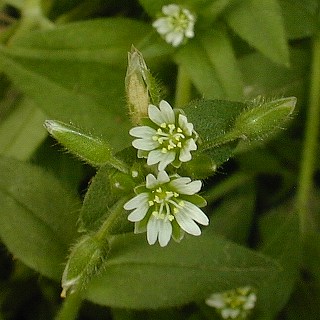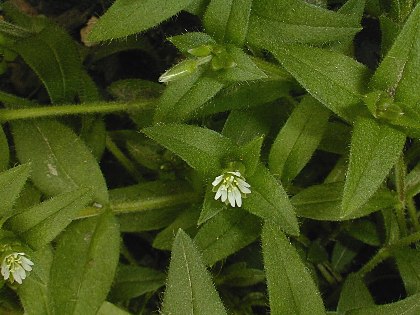Description:
This
herbaceous perennial plant is tufted at the base, producing multiple
stems up to 1½' long, although they are usually about one-half of this
length or less. These stems are ascending to widely spreading; they are
green or purple, terete (round in cross-section), and pubescent. The
opposite leaves are up to 1" long and 1/3" across (or a little larger);
they are variably shaped, including lanceolate-ovate, oval-oblong, or
broadly oblanceolate. The leaves are pubescent, smooth along the
margins, and sessile at the base; they have a prominent central vein on
the upper surface. The stems often terminate in small cymes
(flat-headed clusters) of 1-5 small flowers; both the peduncles and
pedicels of these cymes are pubescent. At the base of each cyme, there is a pair
of leafy bracts with thin translucent margins. Each flower is up to ¼"
across, consisting of 5 green sepals, 5 white petals with notched tips,
10 stamens with pale yellow anthers, and 5 styles; some plants may
produce flowers with fewer than 10 stamens. The sepals are lanceolate,
pubescent, and translucent along their margins; they are about the same
length as the petals. The blooming period occurs intermittently from
late spring to early fall and may last several months for individual
plants. Each flower is replaced by a cylindrical seed capsule with 10
small teeth along its upper rim. Each seed capsule containing several
small seeds. The seeds are somewhat flattened and minutely warty or
pebbly. The root system is mostly fibrous. This plant reproduces
primarily by reseeding itself; it can also form vegetative offsets when
the nodes of the lower stems develop rootlets while lying on moist
ground.
of these cymes are pubescent. At the base of each cyme, there is a pair
of leafy bracts with thin translucent margins. Each flower is up to ¼"
across, consisting of 5 green sepals, 5 white petals with notched tips,
10 stamens with pale yellow anthers, and 5 styles; some plants may
produce flowers with fewer than 10 stamens. The sepals are lanceolate,
pubescent, and translucent along their margins; they are about the same
length as the petals. The blooming period occurs intermittently from
late spring to early fall and may last several months for individual
plants. Each flower is replaced by a cylindrical seed capsule with 10
small teeth along its upper rim. Each seed capsule containing several
small seeds. The seeds are somewhat flattened and minutely warty or
pebbly. The root system is mostly fibrous. This plant reproduces
primarily by reseeding itself; it can also form vegetative offsets when
the nodes of the lower stems develop rootlets while lying on moist
ground.
Cultivation:
The preference is full sun to light shade and moist to slightly dry
conditions. This plant can tolerate a broad range of soils, including
those that contain loam, clay-loam, and pebbly or gravelly material.
Common Mouse-Eared Chickweed is more often found in fertile soil than
other Cerastium spp. (Mouse-Eared Chickweeds). It
is a larger plant that can tolerate more competition from other kinds
of vegetation.
Range & Habitat:
Common Mouse-Eared Chickweed occurs in every county of Illinois; it is
quite common (see Distribution
Map). This species was accidentally introduced into North
America from Eurasia. Habitats
include fields, pastures, lawns, gardens, roadsides, areas along
railroads, areas adjacent to buildings, vacant lots, degraded grassy
meadows, and waste areas. Areas with a history of disturbance provide
preferred habitats.
Faunal Associations:
The flowers attract various bees and flies; these insects suck nectar
primarily, although some Syrphid flies feed on the pollen and some of
the smaller bees (e.g., Halictid bees) collect pollen for their larvae.
The caterpillars of several moths feed on the foliage of Chickweeds (Cerastium
spp., Stellaria spp.), including Agrostis
venerabilis (Venerable Dart), Haematopis grataria
(Chickweed Geometer), and Lobocleta ossularia (Drab
Brown Wave). Sparrows and other small granivorous songbirds eat the
seeds of Chickweeds. Because Common Mouse-Eared Chickweed is one of the
larger Chickweeds that grows during the summer, the Cottontail Rabbit
nibbles on its foliage occasionally.

Photographic
Location:
An area adjacent to a building in Champaign-Urbana, Illinois.
Comments:
This adaptable plant is probably the most common Cerastium sp.
(Mouse-Eared Chickweed) in Illinois. Compared to the similar Stellaria
spp. (Chickweeds), Mouse-Eared Chickweeds usually have more
pubescent leaves and their flowers have 5 styles, rather than 3. Among
the many Mouse-Eared Chickweeds that occur in Illinois (most of them
are introductions from Eurasia), Common Mouse-Eared Chickweed is the
only one with a perennial habit and it is often larger in size. It also
blooms later in the year (typically during the summer), while the
annual species of Mouse-Eared Chickweed bloom primarily during the
spring. A scientific synonym of Common Mouse-Eared Chickweed is Cerastium
vulgatum.